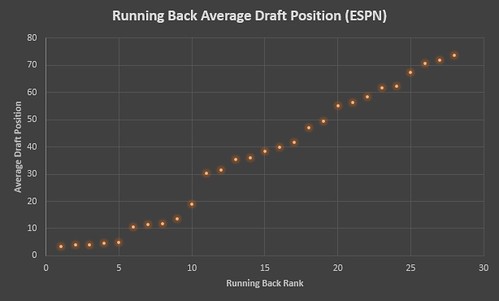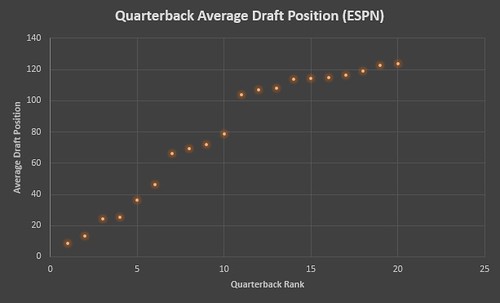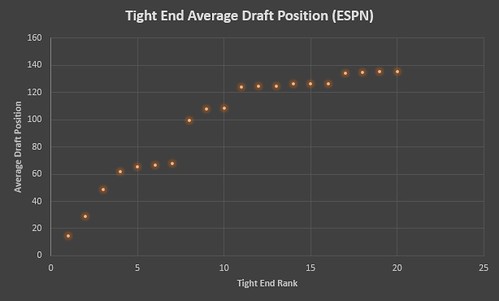Using Positional Average Draft Position Tiers to Maximize Your Fantasy Football Draft

Y'all know that feeling. You're all geared up to pick that running back you wanted with your second-round pick. You had already closed your eyes, imagining the two of you frolicking down the beach of fantasy football bliss. And, just like that, he's gone.
Panic.
You're on the clock, and suddenly the player you had your heart set on is no longer an option. Do you just settle for the next best running back? Or do you go to another position completely?
Positional ADP tiers can help make this decision a whole lot easier. What I mean by that is looking at the average draft position (ADP) of whatever site you're on and seeing where there are large gaps in the ADP of players at the same position. I generally look at Fantasy Football Calculator, as it also shows me the standard deviation of each player. The former stats major in me gushes a little bit over that, but you really can choose any source you want.
The reason I try to have a firm grasp of these tiers before I enter a draft is so that I can know when it's best to forgo a certain position, knowing many of the same players I would have been selecting will be available in a later round. If I can get either Mark Ingram, Melvin Gordon, or any other running backs with a similar ADP in the third round, why would I draft them in the second?
In this, I'm going to go through a few positional ADP tiers that exist at the time of this writing. That said, these are obviously going to fluctuate pretty heavily before the large majority of season-long drafts occur. The intent is to point out the usefulness of this mind-set so you can maximize the value of your draft picks. While the players involved may change, there will still be tiers which you can exploit.
Running Backs
It was those jolly old gallopers who made this an interesting little study. There are a bunch of tiers of backs from which to choose, and they should play a decent role in your draft-day strategy.
The chart below shows the ADP's of the 28 running backs currently going within the top 75 picks of ESPN leagues. You can't see the names (I got space limits, yo), but you can find the data at this link. It should be pretty clear why we're investigating tiers here.
As you can see, there are three pretty distinct tiers right at the top. Why and how should they affect your mindset when drafting?
Let's say you're drafting in the eighth spot in the first round. The top five running backs are off the board. You can either snag one of the top wide receivers, or you can dip down for the sixth-ranked running back, whose ADP sits at 10.5.
For me, I'm going with the receiver every time. I know that if I do so, almost every time there will be either a running back from that next tier or Jeremy Hill (that dot in no man's land at the 10th-ranked running back) available at my next pick.
This same concept applies after Hill flies off the board. The drop-off from him to the running backs going (generally) in the third round is significant. If I miss out on that second tier of running backs, it only makes sense that I would roll with a wide receiver and snag a running back in the third.
After that, the tiers are a bit less defined. We do see big drop from the 17th-ranked running back (Frank Gore) to the 20th (Joseph Randle). There are two players between there, but it's still not a bad little soft spot between those two guys to address other positions.
Wide Receivers
Unfortunately, we can't have as much fun with these big ol' pups. The tiers are less defined, but there is still plenty we can learn from them.
Again, below is a chart of the ADP's of the wide receivers being drafted in the top 75 of ESPN drafts. Surprisingly, it's the exact same number as the running backs, so I didn't even have to change the chart dimensions. Blessed.
See that little dot at the bottom? Yeah. That's Antonio Brown. He's his own tier. Certified freak and lover of fantasy goodness.
After that, there is a mini tier from the second-ranked receiver (Dez Bryant) to the sixth (Calvin Johnson). You have wide receivers seven and eight floating in free space before getting to another mini tier with an ADP around 26.
If you'll recall, there was also a drop-off in roughly that same area for running backs. Problem? Kind of. The odds are that one of the players -- whether it be a back or a receiver -- from the second tier will still be chilling around with a pick between 21st and 26th overall. If they slip, great. Snag them up. If not, and you don't want to go to another position, then you might be forced to reach. That just doesn't seem like a very likely scenario.
Quarterbacks
The fantasy gods like all of you. Because they couldn't provide much clarity with the wide receivers, they decided to make up for it with the quarterback. The tiers don't get much more defined than the chart below.
The big takeaway here is that, after you get back the 10th-ranked quarterback, it's basically a free-for-all. Based on ADP, there isn't a huge difference between the 11th-ranked quarterback and the guy in 20th. If you miss out on the 10th-ranked guy, why not just wait a few rounds and snag someone at a much-reduced price?
That middle little tier currently includes Cam Newton, Matt Ryan, Tony Romo, and Tom Brady. The interesting thing here is that there is even a wide range within that tier with Newton going a full round before Brady in 12-team leagues. If you want one of those quarterbacks and are picking in the sixth round, you could probably hold off until the seventh and still get one of those guys. Whether or not you actually want Brady is another discussion, but like I said, this is meant to be more broad than specific.
Tight Ends
You remember those drop-offs within the quarterback tiers? I mean I'd hope so, considering that was about a paragraph ago. But I ain't here to judge. Either way, we see similar tiers here, but it's a whole heck of a lot bigger with the tight ends.
After the seventh-ranked guy (Julius Thomas) falls off the board, the next tight end to go is Zach Ertz a full 32 picks later. Then within a few picks, you're in a zone where the difference between Tight End X and Tight End Y is miniscule. This is another zone where it can't hurt to wait if you miss out on the tier involving Thomas.
As far as the top-line guys, you'll have more of a guessing game with them. They are, essentially, tiers of their own. Once Rob Gronkowski is gone, it makes sense to wait on Jimmy Graham. Same thing from Graham to Greg Olsen, Olsen to Travis Kelce. It's possible there could be a "run" on tight ends, but if it happens, you can always get one later with no harm done.
Exceptions
Like most things, there will be exceptions to this. If there's a player in your tier that you value much more than others, it's okay to make sure you get him. If you know the odds Player X is available at your next pick are low and you value him more than the other guys available, then it's a'ight to take him a bit early. Why not?
Additionally, the flow of the draft will often dictate and shape these tiers. If you notice that running backs from one tier are going higher than normal, then the guys at the end of that tier probably won't last as long as their ADP would indicate. Each draft is different, and it's important to adapt on the fly.
At the end of the day, the advantage you gain by being cognizant of positional ADP tiers probably isn't huge. But what it can do is help minimize that panicked feeling when you run out of options. If you know the basic structure of the ADP tiers at that time, you can make better decisions to maximize the value of each pick.




















